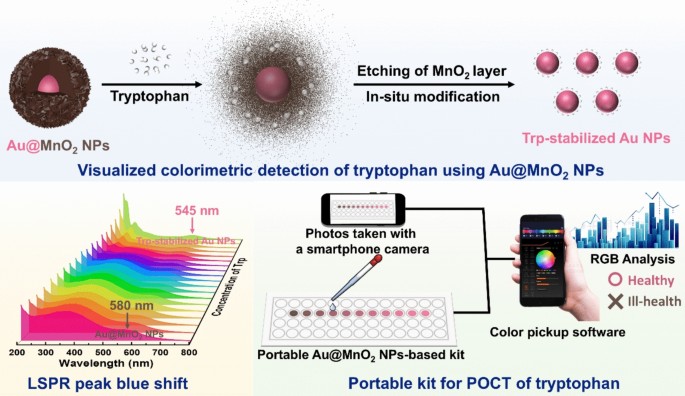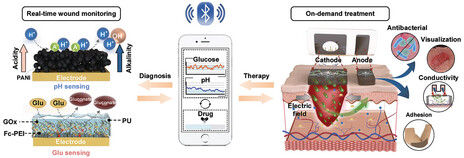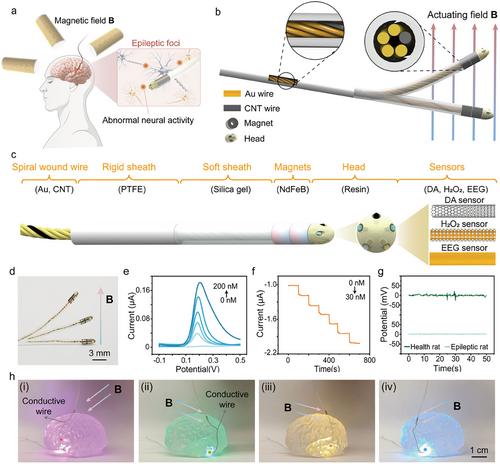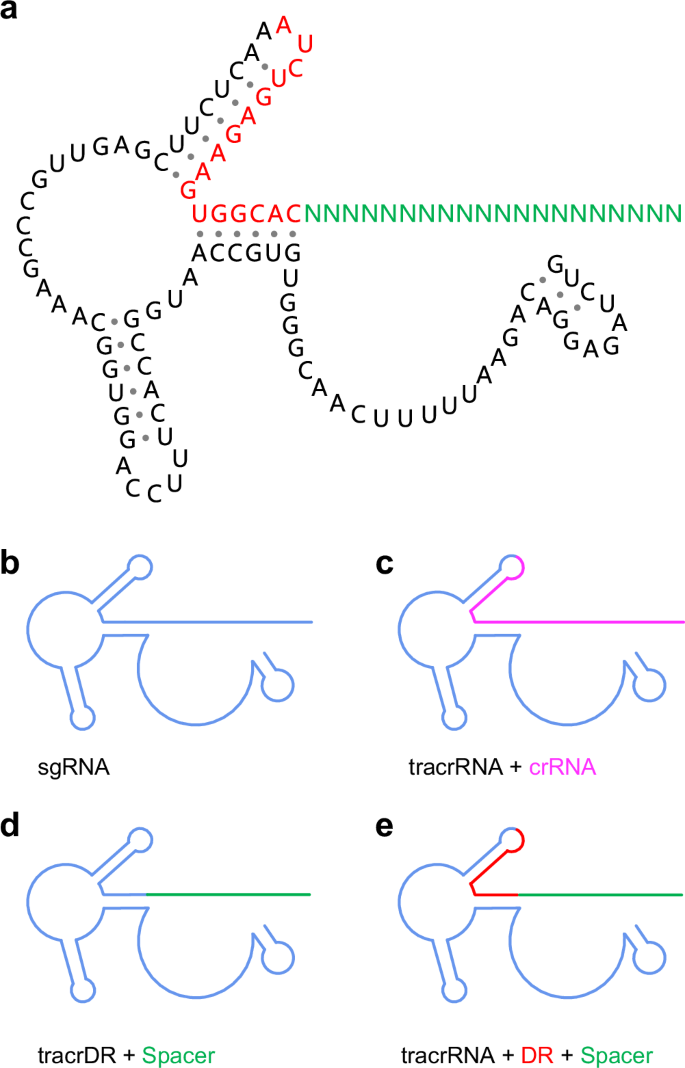课题组主要研究方向:
1. 生物医学传感技术:基于纳米材料的可控合成与功能化,开发生物医学传感新技术和多元分析新探针,实现复杂样本中和细胞内生化标志物的超灵敏和高特异性检测与成像;
2. 现场快速检测系统:基于智能移动终端和单片机平台,开发高灵敏和高特异的生物医学传感新器件和便携式智能化新仪器,实现复杂样本中生化标志物的原位现场快速检测;
3. 纳米生物材料:从分子到细胞水平研究纳米材料与生物大分子相互作用机理,基于纳米材料的可控合成与功能化,开发诊疗一体化纳米生物新材料用于生物成像和同步治疗。
最新进展
Point-of-Care Testing for Abnormal Amino Acid Metabolism: Visualized Colorimetric Detection of Tryptophan Based on Au@MnO2 Nanoparticles
Huang, Y.; Zhuang, X. T.; Zhang, R. Y.; Yu, Q. H.; Kuang, Z. W.; Qiu, C. B.; Luo, Z. F.; Rong, M. C*.
Journal of Analysis and Testing, 2025
https://doi.org/10.1007/s41664-025-00381-y

Abstract. In this study, a novel colorimetric detection method for tryptophan is developed using Au@MnO2 NPs based on their redox reaction. Tryptophan etches the outer MnO2 NPs shell and forms a stable protective layer outside the released Au NPs core in situ, accompanied by a noticeable color change from brown to pink. According to the absorbance ratio of 545 nm and 580 nm (A545/A580), a rapid (within 1 min), accurate, and specific detection method for tryptophan is constructed amidst other common amino acids. Coupling with a smartphone application, integrated Au@MnO2 NPs-based portable test strips can be used for the point-of-care testing (POCT) of tryptophan.
A Magnetically Actuated Neural Probe for Multi-Focal Location in Epilepsy
Wang, C.; Gao, J.; Zheng, Y.; Duan, H.; Zhang, Y.; Wu, T.; Li, Y.; Yu, S.; Xie, X.; Yi,C. Q.* ; Jiang, L. L.*
Advanced Materials Technologies, 2025
https://doi.org/10.1002/admt.202500308

Abstract. Intractable epilepsy often requires the use of stereo-electroencephalography (SEEG) for localizing the epileptic focus. However, SEEG is associated with high invasiveness and relatively limited localization accuracy. This study presents a novel magnetically actuated neural probe (MANP) that integrates remote magnetic navigation and multimodal sensing capabilities to achieve precise localization of epileptic foci. MANP can controllably navigate and accurately target the potential regions of epileptic foci through a single surgical microhole under magnetic actuation. Equipped with multimodal biosensors, MANP tracks EEG signals and neurotransmitter levels (dopamine and hydrogen peroxide) in real-time, providing detailed insights into abnormal brain activities. In vivo experiments with epileptic rats, MANP detected elevated levels of dopamine and hydrogen peroxide alongside high-frequency (4–30 kHz) EEG signals at seizure onset. It effectively identifies multiple suspicious lesions via a single skull entry point under magnetic navigation, distinguishing epileptic from normal brain regions. Therefore, MANP enables minimal invasion, remote magnetic navigation, multi-modal detection, and multi-focal localization, providing a versatile platform for the precise localization of epileptic foci and potential treatment of other neurological disorders.
Regulating cleavage activity and enabling microRNA detection with split sgRNA in Cas12b
Wang, J. Q.; Ye, X. F.; Liu, Y. F.; Li, W. T.; Zhang, X.; Zhang, W.; Yi, C. Q.; Liu, C. X.*
Nature Communications, 2025
https://doi.org/10.1038/s41467-025-61748-4

Abstract. The CRISPR-Cas12b system has revolutionized molecular diagnostics, yet its reliance on single guide RNAs (sgRNAs) exceeding 100 nt limits precise regulation and applications. We present a split sgRNA strategy for Cas12b, utilizing universal components with customizable Spacer to detect various nucleic acid targets by simply replacing Spacer. Glyoxal labeling of the universal split direct repeat (DR) region represses Cas12b activity, which is restored by elevated temperatures or prolonged incubation, enabling dynamic regulation. Incorporating a photo-cleavable linker into the DR allows UV-mediated modulation, ensuring compatibility with recombinase polymerase amplification. Successful detection of Epstein-Barr virus in clinical plasma samples matched the sensitivity of traditional qPCR. Importantly, microRNAs can replace the Spacer, enabling direct detection without reverse transcription or amplification. Supported by evidence from cultured cells and plasma from healthy individuals and colorectal cancer patients, this method yields consistent results with RT-qPCR while simplifying protocols. This split strategy enhances Cas12b systems, offering a promising approach for clinical nucleic acid analysis.
Microneedle-based Integrated Pharmacokinetic and Pharmacodynamic Evaluation Platform for Personalized Medicine
Yang, J.;# Gong, X.;# Zheng, Y.;# Duan, H.; Chen, S. J.; Wu, T.; Yi, C. Q*.; Jiang, L. L.;* Haick, H.
Nature Communications, 2025
https://doi.org/10.1038/s41467-025-61549-9

Abstract. Precision and personalized medicine for disease management necessitates real-time, continuous monitoring of biomarkers and therapeutic drugs to adjust treatment regimens based on individual patient responses. This study introduces a wearable Microneedle-based Continuous Biomarker/Drug Monitoring (MCBM) system, designed for the simultaneous, in vivo pharmacokinetic and pharmacodynamic evaluation for diabetes. Utilizing a dual-sensor microneedle and a layer-by-layer nanoenzyme immobilization strategy, the MCBM system achieves high sensitivity and specificity in measuring glucose and metformin concentrations in skin interstitial fluid (ISF). Seamless integration with a smartphone application enables real-time data analysis and feedback, fostering a pharmacologically informed approach to diabetes management. The MCBM system’s validation and in vivo trials demonstrate its precise monitoring of glucose and metformin, offering a tool for personalized treatment adjustments. Its proven biocompatibility and safety suit long-term usage. This system advances personalized diabetes care, highlighting the move towards wearables that adjust drug dosages in real-time, enhancing precision and personalized medicine.
A portable smartphone-based electrochemiluminescence device integrated with bipolar electrode detection chip for multi-target respiratory pathogen detection
Zhang, R.F.#; Dai, D. S.#; Cao, Y. G.#; Huang, Y.; Wang, K.; Zou, G. R.; Liu, C. X.*, Luo, Z. F*.;Yi,C. Q*
Biosensors and Bioelectronics, 2025
https://doi.org/10.1016/j.bios.2025.117783

Abstract. At-home nucleic acid testing enables early detection of respiratory pathogens, making it crucial for infection control and community transmission reduction, particularly in resource-limited settings. This research develops a system for field-based multiplex respiratory pathogen detection: 1) A portable smartphone-based electro-chemiluminescence (ECL) detection device (termed as the PEMD), constructed using LEGO blocks, capable of precise temperature control for Loop-mediated isothermal amplification (LAMP), and equipped with a custom-developed smartphone app for accurate collection and automatic processing of ECL signals; 2) A bipolar elec-trode and position-resolved ECL sensor chip (termed as the B-chip) that links adjacent amplification and detection zones in series, using DNA-binding redox probe to detect quenching of the ECL signal in positive samples. The system can simultaneously detect H1N1, H7N9, influenza B, and human adenovirus, with a detection limit of 10 copies/μL in simulated samples, and identify 87.5 % of positive samples and 91.7 % of negative samples in clinical samples in good agreement with the gold standard qPCR method. This system shows high sensitivity, specificity, and rapid detection, integrates smartphone imaging and cloud analysis, making it a powerful tool for multiplex respiratory pathogen detection and point-of-care diagnostics.

